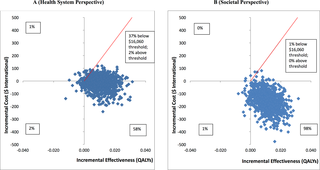PLOS Medicine ( IF 10.5 ) Pub Date : 2017-09-12 , DOI: 10.1371/journal.pmed.1002385 Benedict Weobong 1, 2 , Helen A Weiss 3 , David McDaid 4 , Daisy R Singla 5 , Steven D Hollon 6 , Abhijit Nadkarni 1, 2 , A-La Park 4 , Bhargav Bhat 2 , Basavraj Katti 2 , Arpita Anand 2 , Sona Dimidjian 7 , Ricardo Araya 1, 8 , Michael King 9 , Lakshmi Vijayakumar 10 , G Terence Wilson 11 , Richard Velleman 2, 12 , Betty R Kirkwood 1 , Christopher G Fairburn 13 , Vikram Patel 1, 2, 14

|
Background
The Healthy Activity Programme (HAP), a brief behavioural intervention delivered by lay counsellors, enhanced remission over 3 months among primary care attendees with depression in peri-urban and rural settings in India. We evaluated the sustainability of the effects after treatment termination, the cost-effectiveness of HAP over 12 months, and the effects of the hypothesized mediator of activation on clinical outcomes.
Methods and findings
Primary care attendees aged 18–65 years screened with moderately severe to severe depression on the Patient Health Questionnaire 9 (PHQ-9) were randomised to either HAP plus enhanced usual care (EUC) (n = 247) or EUC alone (n = 248), of whom 95% completed assessments at 3 months, and 91% at 12 months. Primary outcomes were severity on the Beck Depression Inventory–II (BDI-II) and remission on the PHQ-9. HAP participants maintained the gains they showed at the end of treatment through the 12-month follow-up (difference in mean BDI-II score between 3 and 12 months = −0.34; 95% CI −2.37, 1.69; p = 0.74), with lower symptom severity scores than participants who received EUC alone (adjusted mean difference in BDI-II score = −4.45; 95% CI −7.26, −1.63; p = 0.002) and higher rates of remission (adjusted prevalence ratio [aPR] = 1.36; 95% CI 1.15, 1.61; p < 0.009). They also fared better on most secondary outcomes, including recovery (aPR = 1.98; 95% CI 1.29, 3.03; p = 0.002), any response over time (aPR = 1.45; 95% CI 1.27, 1.66; p < 0.001), higher likelihood of reporting a minimal clinically important difference (aPR = 1.42; 95% CI 1.17, 1.71; p < 0.001), and lower likelihood of reporting suicidal behaviour (aPR = 0.71; 95% CI 0.51, 1.01; p = 0.06). HAP plus EUC also had a marginal effect on WHO Disability Assessment Schedule score at 12 months (aPR = −1.58; 95% CI −3.33, 0.17; p = 0.08); other outcomes (days unable to work, intimate partner violence toward females) did not statistically significantly differ between the two arms. Economic analyses indicated that HAP plus EUC was dominant over EUC alone, with lower costs and better outcomes; uncertainty analysis showed that from this health system perspective there was a 95% chance of HAP being cost-effective, given a willingness to pay threshold of Intl$16,060—equivalent to GDP per capita in Goa—per quality-adjusted life year gained. Patient-reported behavioural activation level at 3 months mediated the effect of the HAP intervention on the 12-month depression score (β = −2.62; 95% CI −3.28, −1.97; p < 0.001). Serious adverse events were infrequent, and prevalence was similar by arm. We were unable to assess possible episodes of remission and relapse that may have occurred between our outcome assessment time points of 3 and 12 months after randomisation. We did not account for or evaluate the effect of mediators other than behavioural activation.
Conclusions
HAP’s superiority over EUC at the end of treatment was largely stable over time and was mediated by patient activation. HAP provides better outcomes at lower costs from a perspective covering publicly funded healthcare services and productivity impacts on patients and their families.
Trial registration
ISRCTN registry ISRCTN95149997
中文翻译:

健康活动计划的持续有效性和成本效益,这是一项由初级保健非专业咨询师提供的针对抑郁症的简短心理治疗:一项随机对照试验的 12 个月随访
背景
健康活动计划 (HAP) 是一项由非专业咨询师提供的简短行为干预措施,在印度城郊和农村地区的初级保健参加者中,抑郁症患者在 3 个月内得到了改善。我们评估了治疗终止后效果的可持续性、HAP 12 个月内的成本效益,以及假设的激活介质对临床结果的影响。
方法和结果
在患者健康问卷 9 (PHQ-9) 中筛查出患有中重度至重度抑郁症的 18-65 岁初级保健参与者被随机分配到 HAP 加强化常规护理 (EUC)( n = 247)或单独 EUC( n = 248) ),其中 95% 在 3 个月时完成评估,91% 在 12 个月时完成评估。主要结局是贝克抑郁量表 II (BDI-II) 的严重程度和 PHQ-9 的缓解程度。 HAP 参与者在 12 个月的随访中保持了治疗结束时表现出的增益(3 个月和 12 个月之间的平均 BDI-II 评分差异 = -0.34;95% CI -2.37, 1.69; p = 0.74),与单独接受 EUC 的参与者相比,症状严重程度评分较低(调整后的 BDI-II 评分平均差 = -4.45;95% CI -7.26,-1.63; p = 0.002)和较高的缓解率(调整后患病率 [aPR] = 1.36;95% CI 1.15,1.61; p < 0.009)。他们在大多数次要结局上也表现更好,包括恢复(aPR = 1.98;95% CI 1.29, 3.03; p = 0.002)、随时间推移的任何反应(aPR = 1.45;95% CI 1.27, 1.66; p < 0.001),报告最小临床重要差异的可能性较高(aPR = 1.42;95% CI 1.17, 1.71; p < 0.001),报告自杀行为的可能性较低(aPR = 0.71;95% CI 0.51, 1.01; p = 0.06) 。 HAP 加 EUC 对 12 个月时的 WHO 残疾评估计划评分也有边际影响(aPR = -1.58;95% CI -3.33,0.17; p = 0.08);其他结果(无法工作的天数、亲密伴侣对女性的暴力行为)在两组之间没有统计学上的显着差异。 经济分析表明,HAP加EUC比单独使用EUC占主导地位,成本更低,效果更好;不确定性分析表明,从卫生系统的角度来看,考虑到每个质量调整生命年的支付意愿为 16,060 国际美元(相当于果阿的人均 GDP),HAP 具有成本效益的可能性为 95%。患者报告的 3 个月时行为激活水平介导了 HAP 干预对 12 个月抑郁评分的影响(β = -2.62;95% CI -3.28,-1.97; p < 0.001)。严重不良事件并不常见,各组的发生率相似。我们无法评估随机分组后 3 个月至 12 个月的结果评估时间点之间可能发生的缓解和复发情况。除了行为激活之外,我们没有考虑或评估中介因素的影响。
结论
在治疗结束时,HAP 相对于 EUC 的优越性随着时间的推移基本上保持稳定,并且是由患者激活介导的。从公共资助的医疗保健服务和对患者及其家人的生产力影响的角度来看,HAP 以更低的成本提供更好的结果。
试用注册
ISRCTN 注册表ISRCTN95149997











































 京公网安备 11010802027423号
京公网安备 11010802027423号